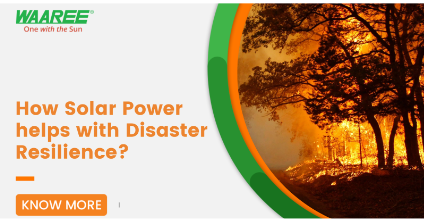











In order to understand more about ‘How Solar Power Helps with Disaster Resilience, one must be aware of the term ‘Disaster Resilience.’
The ability to prevent, withstand and recover from natural hazards is what defines disaster resilience. The ability to be resilient can be developed through knowledge, understanding, and practice, but it does not occur by itself.
In 2017, the Global Platform for Disaster Risk Reduction in Cancun, Mexico published the Disaster Resilience Scorecard for Cities.
Local governments can assess their disaster resilience using the Scorecard, which is structured around UNDRR’s Ten Essentials for Making Cities Resilient.
Two levels of scoring are available on the Scorecard:
Between 2000 and 2019, extreme climatic events have increased exponentially in India over the past 50 years.
Climate change is causing drastic shifts in microclimates across different sectors. The first service to go down in a disaster is electricity.
In most cases, electrical supply infrastructure is highly complex, geographically extensive, and has varying levels of connectivity, making it difficult for supply and demand to be balanced. When electrical systems are damaged, essential services such as water supply, healthcare, communication systems, etc. are affected. Water supply and wastewater drainage disruptions may even seriously threaten public health, hygiene, and sanitation, putting lives at risk.
Losses after a disaster are determined by the coping capacity of the community. Those with low coping abilities are often affected by disasters in cycles, getting hit by the next one before they have recovered from the previous one.
Immediate relief and response activities in the aftermath of a disaster are usually focused on relieving suffering and stabilising the environment. However, they are usually short-term solutions and rapid reactions to unplanned events which may not be sustainable.
Access to a safe built environment along with decentralised energy can be a powerful combination for combating complex challenges after a disaster and for inclusive rehabilitation and rebuilding.
Investment in infrastructure strengthening can break the link between poverty and disasters. The investment should focus on benefiting the poorest who reside in informal settlements and are the most vulnerable. They are also the ones spending the most on maintaining their energy needs.
A decentralised energy system would enable governments to reduce the impact of disasters which in turn could improve human well-being by avoiding recurring recovery and rehabilitation costs. But how do we develop a resilient system for future catastrophes?
An energy system has to be Reliable, Efficient, Affordable and Sustainable. There’s only one energy source which fulfils all the above KPI’s, viz., power generated through a Solar power plant.
Reliable: According to a study done by NREL on Solar panels for reliability, they found that each year 5 panels out of 10,000 fails, which is a meagre .05%. And if coupled with Energy storage devices like Hydrogen, and Li-ion batteries it could even serve as a 24*7 power supply source.
Efficient: Solar Power plants are typically 15-20% efficient, which comes with an unlimited free source of power which is SUNLIGHT.
Affordable: The average cost per KWh for fossil fuels is between $.05 and $0.17 as compared to solar at $0.03 to $0.06.
Sustainable: The most crucial advantage to make energy source is the availability of raw materials to produce energy, which in the case of Solar power plants is long-lasting and never-ending SUNLIGHT, viz, a very sustainable source of raw material for solar power plant. Moreover, solar power plants are GREEN energy enabled which means their CO2 footprint is low as compared to fossil fuels, which makes them more environmentally friendly and added another star to the scale of sustainability.
See Also: Solar Energy: What you need to know
Highlight 1: Solar Powered Bus for Water purification
This bus was used in Aug 2018, in Kerala and has a capacity to purify 3000 litres of water per hour using Solar Power. It was used as a remote safe drinking facility for flood-struck people of Kerala.
It was indigenously developed by scientists at CSMCRI Bhavnagar.
Highlight 2: Solar power is helping the people of Puerto Rico after hurricane FIONA blackouts
Puerto Rico has long suffered power outages since Hurricane Maria upended the grid. Community organizers, nonprofits and environmentalists are calling for a solar power revolution in Puerto Rico as solar power proves resilient in the face of this latest hurricane. Address the impacts of climate change that survive.
In Puerto Rico, an average of over 2,800 new solar projects are installed in buildings each month.
Nonprofits such as Solar Responders are working to install solar panels in fire stations around the island so that first responder can continue working when the grid goes out. They helped install renewable energy in nearly 20% of Puerto Rico’s fire departments.
Like that there are many such success stories of Solar Power plants during disasters. Solar Power provides you with ‘energy security during disaster times. Moreover, it does not generate any Air, water or land pollution throughout its lifetime, also it is silent to operate which reduces noise pollution as well. What are you waiting for? We are helping thousands of people to GO SOLAR WITH WAAREE. Know more about WAAREE.
Waaree Energies Ltd. is the flagship company of Waaree Group, founded in 1989 with headquarters in Mumbai, India. It has India’s largest Solar panel manufacturing capacity of 5GWs at its plants in Surat and Umbergaon in Gujarat. Waaree Energies is amongst the top players in India in Solar Panel Manufacturing, EPC Services, Project Development, Rooftop Solutions, and Solar Water Pumps and is also an Independent Power Producer. Waaree has its presence in over 380 locations nationally and 20 countries internationally. Step on to your cleaner journey by contacting us at 1800-2121-321 or mail us at waaree@waaree.com
Read Further: What is SBSP (Space Based Solar Power)?